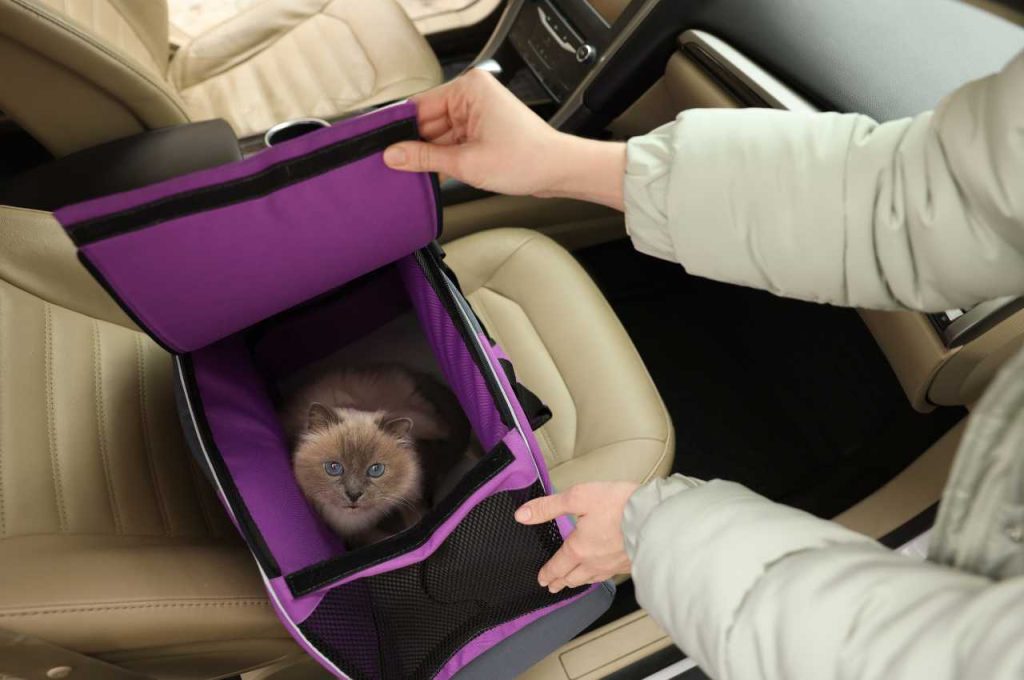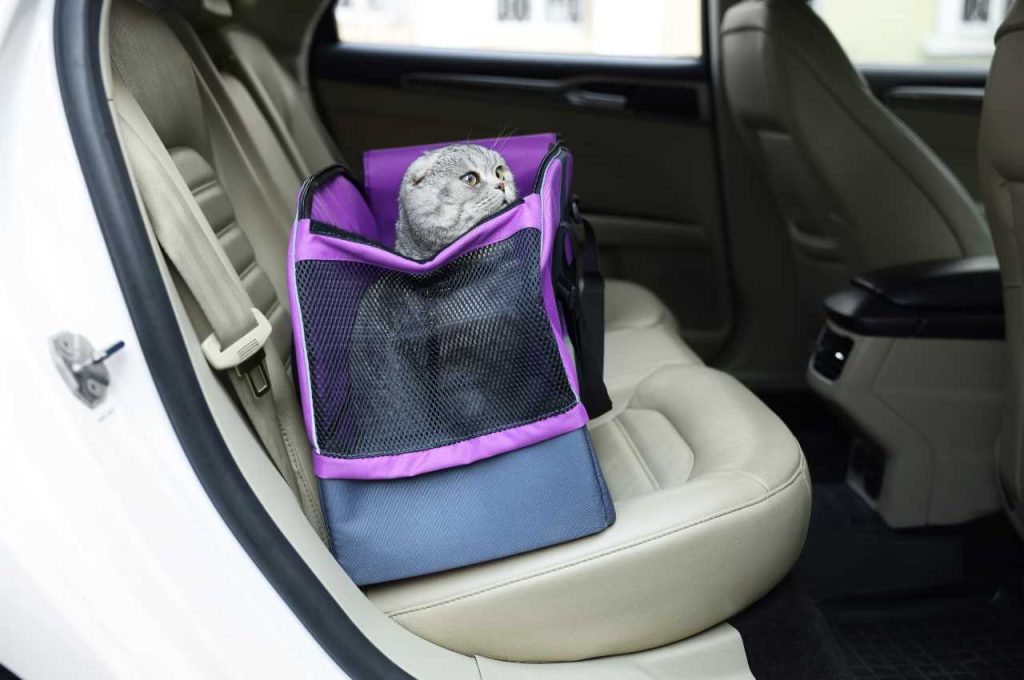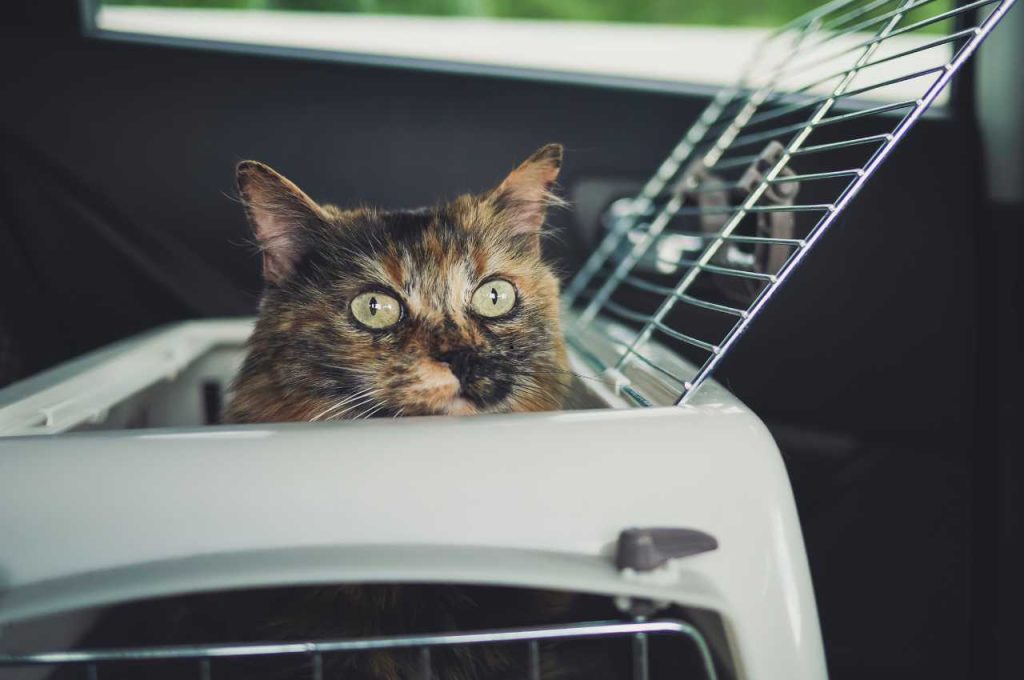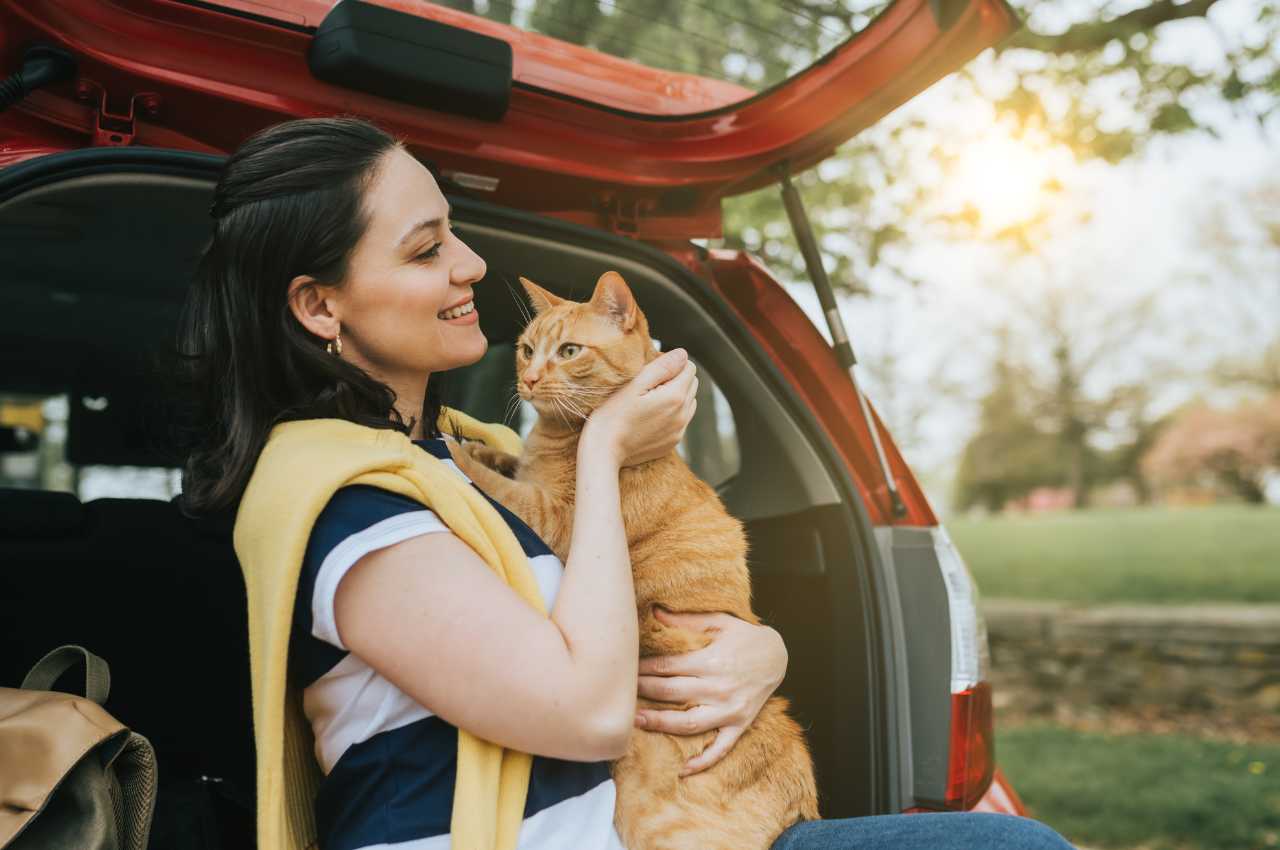To transport a cat in a car, use a secure carrier and place it in the back seat. Ensure good ventilation and make sure the carrier is stable and comfortable for the cat.
Proper preparation and a calm environment are key to a successful car journey with your feline companion. Cats can be sensitive to changes, so creating a familiar and cozy space will help keep them at ease during the ride. Additionally, it’s important to make stops for bathroom breaks and to offer water if the journey is long. By following these tips, you can ensure a safe and stress-free car trip for your cat.
Preparing Your Cat for The Journey
Preparing your cat for a car journey is crucial for a smooth and stress-free experience. Follow these tips to ensure your feline friend stays comfortable and secure during transport.

Familiarizing Your Cat With The Carrier
Getting your cat ready for a car ride is essential for a stress-free experience. Familiarize your cat with the carrier in advance. Place the carrier in a common area with the door open and let your cat explore it on its own terms.
Create a positive association by placing treats and toys inside the carrier. Set up the carrier as a cozy space. Line it with a soft blanket or towel for comfort. Include familiar items like your cat’s favorite toy to provide a sense of security. Ensure proper ventilation by having openings on the carrier for air circulation. Introduce your cat to short car rides to acclimate to the experience. Use a calming pheromone spray or a familiar blanket with comforting scents inside the carrier. Avoid feeding your cat right before the journey to prevent motion sickness.
Always secure the carrier in the car to prevent it from moving during the journey. Place the carrier on a stable surface in the back seat. Use a seatbelt or secure it with the car’s seat belt to ensure safety. Remember, a prepared and comfortable cat is more likely to remain calm and relaxed during car rides. By following these steps, you can make traveling with your feline friend a smoother and enjoyable experience.
Choosing The Right Carrier
When it comes to transporting your feline friend in a car, choosing the right carrier is crucial for their safety and comfort. The right carrier will provide a secure and calming environment, making the journey less stressful for your cat.
Size and Ventilation
The size of the carrier plays a vital role in ensuring your cat’s comfort during travel. It should be spacious enough for your cat to stand up, turn around, and lie down comfortably. A well-ventilated carrier is essential to maintain proper airflow, preventing your cat from feeling too confined and ensuring they have access to fresh air.
Secure and Sturdy Options
A secure carrier with sturdy construction is essential to keep your cat safe during the journey. Look for carriers with reliable locking mechanisms to prevent any accidental escapes. Sturdy materials such as hard plastic or metal mesh provide durability and protection for your cat.
Training Your Cat for Car Travel
Preparing your cat for car travel requires patience and training. Start by getting your cat comfortable with the carrier and gradually introduce them to short car rides. Make sure they have access to food, water, and a litter box during the trip.
Short Practice Drives
Begin with short drives to get your cat acclimated to the car environment. Gradually increase the length of drives to build your cat’s tolerance. Provide a comfortable carrier and secure it properly in the car.
Positive Reinforcement Techniques
Use treats and praise to create a positive association with car travel. Start by rewarding your cat for being in the carrier without moving. Slowly progress to rewarding calm behavior during short drives. Remember to speak softly and reassure your cat during the journey.
On The Day of Travel
Transporting a cat in a car can be a challenge, but with these helpful tips, it can be made easier. Ensure your furry friend’s safety by using a secure carrier, providing comfort, and making regular stops for breaks and hydration during the journey.
Feeding Before The Trip
Properly feeding your cat before the trip is essential to ensure their comfort and prevent any potential messes during the journey. It’s best to feed your cat a few hours before the trip, giving them enough time to digest their food. Avoid feeding them a large meal right before the journey, as this can lead to an upset stomach.
Instead, offer your cat a small portion of their regular meal or some treats. This will keep them satisfied without overfilling their stomach. Additionally, make sure to provide fresh water to keep your cat hydrated throughout the trip.
Last-minute Carrier Preparation
Preparing the carrier just before the trip is crucial to ensure your cat’s safety and comfort during the car ride. Start by lining the carrier with a soft blanket or towel to create a cozy and familiar environment for your cat. This will also help absorb any accidents or spills that may occur.
Place the carrier in an easily accessible location, allowing your cat to become familiar with it before the journey begins. Leave the carrier open so your cat can explore and enter it voluntarily. Spraying a calming pheromone spray, available at pet stores, inside the carrier can also help alleviate any anxiety your cat may be feeling.
Before placing your cat inside the carrier, ensure that it is secure and stable. Double-check the latches and fastenings to avoid any mishaps during the car ride. It’s also a good idea to cover the carrier with a light towel or cloth to create a sense of privacy for your cat. Remember to keep the carrier within your sight while driving, but never place it on a seat or hold it in your lap. It’s best to secure it on the floor of the car, either in the backseat or in the footwell, using a seatbelt or other restraints. This will prevent the carrier from sliding or tipping over in case of sudden stops or turns.
By following these steps and ensuring your cat is comfortable and secure in their carrier, you can make the day of travel a stress-free experience for both you and your feline companion.
Securing The Carrier in The Car
Safely transport your cat in the car by securing them in a comfortable carrier. Place the carrier on the back seat and ensure good ventilation to keep your feline friend calm during the journey. Remember to make stops for breaks and never leave your cat unattended in the vehicle.

Securing the Carrier in the Car is an essential part of transporting a cat safely. A sturdy and well-ventilated carrier is a must-have, but it’s equally important to secure it properly in the car. This will not only prevent your cat from escaping or getting injured in case of sudden stops or accidents but also ensure your own safety as a driver. Let’s look at the Best Positions for Safety and Using Seat Belts and Carrier Straps in more detail.
Best Positions for Safety
The safest position for the carrier is in the back seat of the car. This not only ensures that your cat is away from the airbag but also provides a more stable and comfortable ride. If you have a larger vehicle like an SUV, you can place the carrier in the cargo area, but make sure it is secured and won’t slide around during the ride. Avoid placing the carrier in the front seat, especially if your car has airbags that could deploy in case of an accident.
Using Seat Belts and Carrier Straps
One of the easiest ways to secure the carrier is by using a seat belt. Most carriers have built-in straps that you can use to buckle them up. Simply place the carrier in the desired position, thread the seat belt through the straps, and buckle it up. Another option is to use carrier straps that attach directly to the car’s seat belt. These straps provide an extra layer of security and prevent the carrier from tipping over or sliding around. Make sure to tighten the straps properly and check them periodically during the ride.
In conclusion, securing the carrier in the car is crucial for your cat’s safety and your own. By following these Best Positions for Safety and Using Seat Belts and Carrier Straps, you can ensure a smooth and stress-free ride for both you and your furry companion.
Creating a Calm Environment
To create a calm environment for transporting a cat in a car, it’s essential to use a comfortable carrier with familiar bedding. Placing the carrier in a secure spot and introducing the cat to short car trips can help reduce anxiety. Additionally, playing soothing music during the journey can also help keep the cat calm.
Creating a calm environment is crucial when transporting a cat in a car. Cats can easily get stressed during car rides, so it’s essential to take steps to keep them calm and comfortable. This section will discuss two important factors: controlling the temperature and playing soothing music.
Controlling The Temperature
Maintaining a comfortable temperature inside the car is essential for your cat’s well-being. Extreme temperatures can make them agitated or even cause health issues. Here’s how you can ensure the right temperature:
- During hot weather, set the car’s air conditioning system to a cool temperature. Avoid blasting cold air directly at your cat, as it may make them uncomfortable. Instead, create a gentle airflow throughout the car.
- In cold weather, set the heater to a warm but not overly hot temperature. Keep in mind that cats are sensitive to heat, so avoid overheating the car.
- Monitor the temperature inside the car using a thermometer. Aim for a range between 65°F (18°C) and 75°F (24°C) to provide a comfortable environment.
Playing Soothing Music
Music can have a calming effect on cats, helping to reduce anxiety during car rides. Consider the following tips when choosing and playing soothing music:
- Opt for soft, slow-tempo instrumental music or classical tunes. These genres are generally soothing for cats.
- Avoid loud or fast-paced music, as it may have the opposite effect and increase your cat’s stress levels.
- Play the music at a low volume to create a peaceful ambiance without overwhelming your cat’s sensitive ears.
- Test different types of music to see which ones have a calming effect on your cat. Each cat may have different preferences.
Creating a calm environment is essential for a smooth and stress-free car journey with your cat. By controlling the temperature and playing soothing music, you can help your furry friend feel more relaxed and comfortable throughout the ride. Remember to monitor your cat’s behavior and make adjustments accordingly to ensure their well-being.
Dealing with Anxiety and Motion Sickness
Transporting a cat in a car can be a stressful experience for both the feline and the owner, especially if the cat experiences anxiety and motion sickness. Recognizing the signs of distress and implementing preventive measures can help make car rides more comfortable for your furry friend.
Recognizing The Signs
It’s important to be able to recognize the signs of anxiety and motion sickness in your cat during car rides. Common signs of distress include excessive meowing, panting, trembling, vomiting, and excessive drooling. If your cat displays any of these symptoms, it’s crucial to address the issue to ensure their well-being.
Preventive Measures
Implementing preventive measures can help alleviate your cat’s anxiety and reduce the likelihood of motion sickness during car rides. Some effective preventive measures include acclimating your cat to the car, using a comfortable and secure carrier, limiting food intake before the trip, and providing a familiar blanket or toy to create a sense of comfort and security. Additionally, using calming pheromone sprays or wipes and playing soothing music during the car ride can help relax your cat and minimize anxiety.
After The Journey
Acclimatizing to The New Environment
Upon arrival at your destination, allow your cat to explore its new surroundings at its own pace. Set up a quiet, safe space with familiar items such as bedding, toys, and food and water dishes. To help your cat feel more comfortable, consider using synthetic feline facial pheromone products, which can promote a sense of security and ease the transition to a new environment.

Monitoring for Stress
Keep a close eye on your cat for any signs of stress or discomfort. Observe its behavior, appetite, and litter box habits. If your cat appears stressed, try to minimize noise and activity in the immediate area. Offer reassurance and gentle interaction, but avoid overwhelming the cat with attention. If signs of stress persist, consult a veterinarian for additional guidance.
Conclusion
Overall, transporting a cat in a car may seem like a daunting task, but with the right preparation and approach, it can be a stress-free experience for both you and your feline friend. Remember to create a comfortable environment, secure your cat in a carrier, and plan for breaks and rest stops. By following these tips and being patient with your cat, you can ensure a safe and successful journey together.
